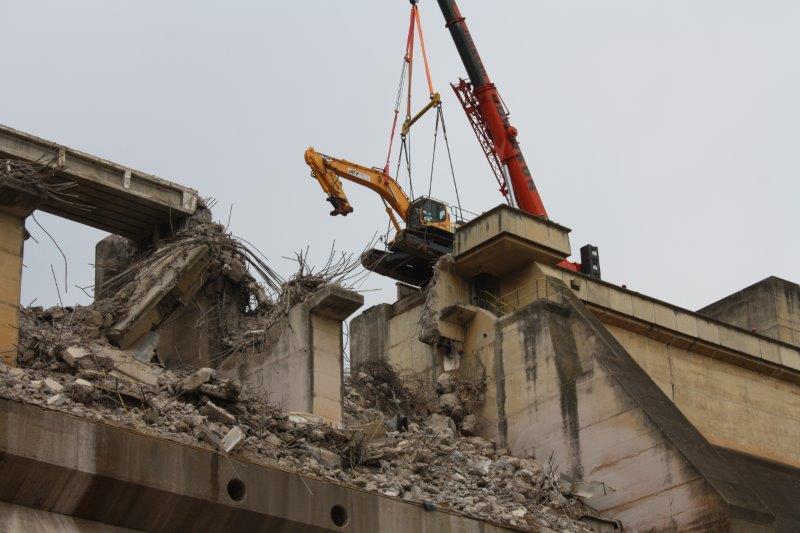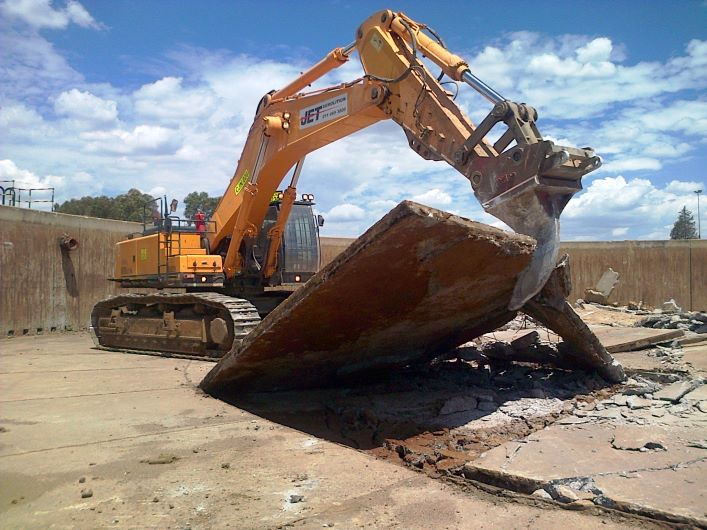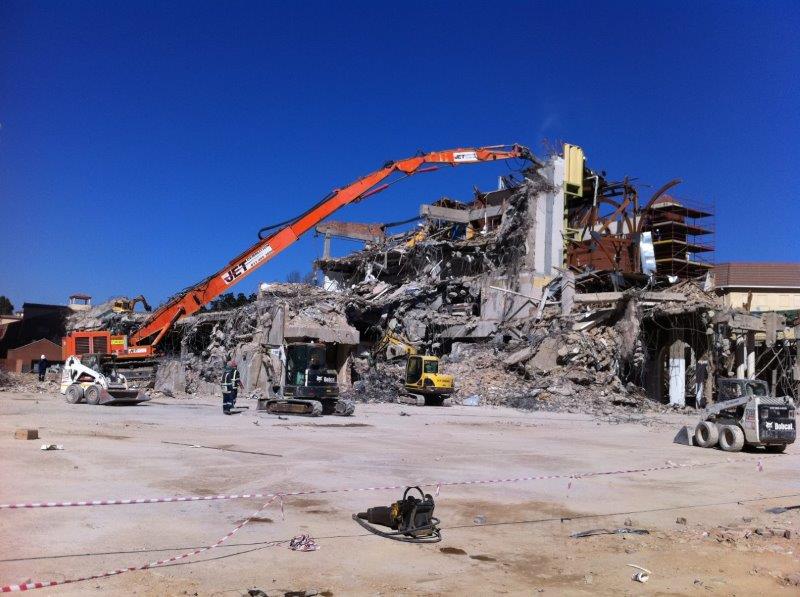
Jet Demolition’s work on large water-retaining dams constitute some
of the most important projects that the specialist contractor has undertaken to
date. These projects call for highly-controlled, cautious, partial demolition
techniques.
Rehabilitation of
dam walls usually requires demolition of redundant portions of monolithic
blocks and associated concrete structures. Dynamic energy imparted by the demolition
process has the potential to cause damage to concrete located just across the
demolition boundaries and beyond. While it is essential to avoid damage to
remaining concrete, it is also important to carry out the demolition works in a
productive and cost-effective manner.
Hence, informed and
judicious selection of demolition methods and their application techniques are
vital to a controlled and productive project – which is where Jet Demolition’s
extensive experience stands it in good stead, Contracts Manager Kate Bester (N. Dip. Civil Engineering)
explains.
“Our work at
Hazelmere Dam allowed for the compilation of specific demolition-control
guidelines to be developed for dam rehabilitation projects,” Bester highlights.
Here a combination of explosive, mechanical, and diamond-cutting methods were
employed.
“In particular, it
was demonstrated that explosives can be used as the primary method of
demolition on dam rehabilitation projects in a safe, productive, and controlled
manner, without causing damage to the remaining mass concrete and concrete
structures.”
Located on the
Mdloti River in KwaZulu-Natal, the Hazelmere Dam was built in the 1970s. It was
designed originally to accept radial arm gates to raise the Full Supply Level
(FSL). However, a subsequent redesign showed that the FSL would be achieved
optimally via a Piano Key Weir (PKW).
To clear the way for
new construction works, demolition of the existing spillway crest, piers,
lintel beam, and bridge decks required the controlled removal of 5 300 m3
of concrete up to 3 m in thickness. “The key requirements were to demolish the
redundant structures in a safe, rapid, cost-effective, and controlled manner,
without residual damage,” Bester elaborates.
The traditional
demolition method for projects with large volumes of mass concrete is
explosives, with large hydraulic hammers used for the smaller concrete sections
and for secondary breakage. Finishing work is typically undertaken by small
hydraulic hammers and handheld breakers.
Despite the advances
in diamond-cutting technologies, this method is usually not practical nor
cost-effective to apply in isolation. The use of drilling and blasting is
unrivalled in terms of speed and cost-effectiveness. However, for obvious
dam-safety reasons, maintaining the structural integrity of the remaining
concrete is a perennial concern when demolition works are carried out on a dam
structure, or in nearby rock.
Due to the energetic
and destructive nature of explosives, valid concerns of damage to the remaining
mass concrete and concrete structures are at the fore when blasting is
considered for dam rehabilitation works.
Drilling and blasting:
It is possible to
combine advances in drilling and wire-rope cutting technologies to effectively
prepare the superstructure for isolated and highly-controlled micro-blasting
activities. A cautious and thoroughly
detailed design approach is critical to ensure that no additional damage will
be introduced into the structure, whilst optimising production and safety. Whilst this option inherently introduces a
new element of risk to the works, proven experience, technical data and a
critical review of site-specific factors all channel into a systematic,
practical and effective approach.
Mechanical
demolition and clearing: Mechanical demolition
is a key facet of partial dam wall demolition, but only if executed with
precision and due care. “Jet Demolition
has developed a range of highly specialised tools and attachments, specifically
targeted at offering the utmost control in sensitive projects,” Bester states.
“Our range of tools and equipment is not generally available in South Africa,
and contributes to our commitment to safety and mechanisation.”
When considering
safe blasting vibration levels for a particular project, it is of critical
importance that cognizance is taken of the prevailing site conditions and
geometrical configurations. “At Hazelmere Dam, our production blasting
programme and demolition methods achieved all of these objectives successfully,”
Brinkmann concludes.
Ends
Connect with Jet Demolition on Social Media to receive the company’s
latest news
Facebook: https://www.facebook.com/JetDemolition/?ref=br_rs
LinkedIn: https://www.linkedin.com/company/jet-demolition-pty-ltd/
Notes to the
Editor
To download hi-res images for this release, please visit http://media.ngage.co.za and click the Jet
Demolition link to view the company’s press office.
About Jet Demolition
Jet
Demolition has been undertaking industrial demolition works since 1994, and is
the leading, largest, and most technically-advanced demolition company in
Africa. It offers in-house, full-range demolition services, including advanced
mechanical solutions and controlled implosions. It actively pursues ongoing
development of skills and equipment suited to the changing needs of the
industry.
Jet
Demolition is a technically-based company, with various staff members holding
MSc, BSc, and BTech Degrees, as well as National Diplomas, in various engineering
fields. This expertise gives it the technical foundation to successfully
engineer solutions for large and complex demolition projects, and furthermore
fuels its drive to deliver quality projects safely. Jet Demolition strives to
offer its clients innovative and technical solutions to demanding demolition
challenges.
Jet Demolition Contact
Kate Bester (N. Dip. Civil
Engineering)
Contracts Manager
Phone: (011) 495 3800
Cell: 072 811 5310
Email: kate@jetdemolition.co.za
Media Contact
Renay
Tandy
NGAGE
Public Relations
Phone:
(011) 867 7763
Fax:
086 512 3352
Cell:
082 562 5088
Email:
renay@ngage.co.za
Web: www.ngage.co.za
Browse the NGAGE
Media Zone for more client press releases and photographs at http://media.ngage.co.za
More news
- DOK-ING’s innovative electric mining equipment unveiled at ElectraMining
- CONCOR’S MASTERY IN FAST TRACK PROJECT IMPLEMENTATION UNDERSCORED BY SAFETY AWARD
- PROMINENT SEA POINT HOTEL REFURBS WITH REHAU
- CONCRETE ROOF TILES USED FOR WALL CLADDING ON COASTAL HOME
- THE GREENEST RESIDENTIAL DEVELOPMENT IN AFRICA?





